#writer tools
Text
The Writer's Guide to Authentic Wounds and Fatalities
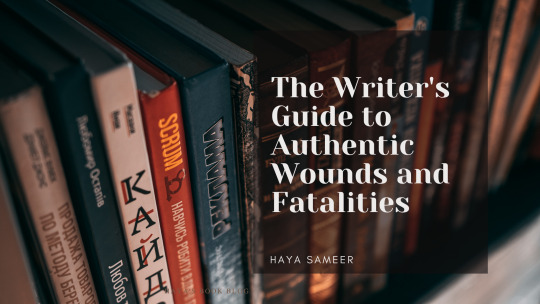
Writing fatal injuries in a story requires a delicate balance between realism and narrative impact. The portrayal of these life-altering events can evoke strong emotions in readers and shape the trajectory of your characters' journeys. In this blog, I will explore the intricacies of depicting fatal injuries in a manner that feels authentic, engaging, and respectful to the gravity of such circumstances. By understanding the nuances of fatal injuries, you will be equipped to craft compelling narratives that resonate with your readers.
Writing Fatal Injuries
When it comes to writing fatal injuries, it is crucial to approach the subject with care and accuracy. Fatal injuries carry immense consequences for your characters and can shape the trajectory of your story. By delving into the intricacies of portraying fatal injuries authentically, you can ensure that the gravity and impact of such events are effectively conveyed to your readers.
Choosing the right injuries for your story
Selecting the appropriate fatal injuries for your narrative involves considering various factors. Ask yourself: What purpose does this injury serve within the story? How does it affect the characters and the overall plot? Conduct thorough research to identify injuries that align with your story's context and resonate with the emotional journey of your characters.
For example, in a historical drama, you may research common fatal injuries during a particular era, such as battlefield injuries, diseases, or accidents prevalent at the time. In a crime thriller, you might explore the portrayal of fatal gunshot wounds or traumatic injuries resulting from violent encounters. By aligning the injuries with the context and themes of your story, you create a more immersive and believable experience for your readers.
Researching the mechanics of fatal injuries
To portray fatal injuries convincingly, it is essential to delve into the mechanics behind them. Understand the specific anatomical structures and systems involved, as well as the forces or mechanisms that can lead to fatal outcomes. Explore medical resources, consult experts if possible, and gather insights into the physiological and psychological implications of such injuries.
For instance, if your character suffers a fatal stab wound, research the anatomy involved, the potential organs affected, and the potential consequences such as internal bleeding or organ failure. By understanding the specific details and implications of the injury, you can describe the physical and emotional toll it takes on the character with greater accuracy and depth.
Depicting the immediate aftermath
When writing about fatal injuries, vividly describe the immediate aftermath to capture the intense emotions and physical realities. Consider the sensory details, the shock and disbelief experienced by characters, and the chaotic environment that often surrounds such events. Balancing realism with the needs of your story, create a scene that immerses readers and evokes empathy.
For example, if a character experiences a fatal car accident, you can depict the chaos at the scene, the character's disorientation, and the reactions of witnesses. Emphasize the sensory details such as the sound of screeching tires or the smell of burning rubber, creating a visceral experience for your readers.
Emotional and dramatic impact on the narrative
The impact of fatal injuries extends beyond the immediate moment. Explore the ripple effects on other characters, relationships, and the overall plot. Delve into the emotional responses, grief, guilt, anger, or determination that arises in the aftermath of loss. Utilize these emotional arcs to deepen character development and drive the narrative forward.
For instance, the loss of a loved one due to a fatal illness might lead to grief and strained relationships among the remaining family members. The emotional journey of a character grappling with guilt and seeking redemption after causing a fatal accident can become a central theme in your story. By delving into these emotional arcs and their consequences, you add depth and resonance to your narrative.
Writing Minor Injuries
While fatal injuries may capture our attention with their dramatic impact, it is equally important to pay attention to the portrayal of minor injuries in your writing. Minor injuries, though less severe, can still significantly affect your characters and contribute to the authenticity of your story. In this section, we will explore the art of depicting minor injuries, ensuring that they are not overlooked or trivialized. By delving into the nuances of minor injuries, you can add depth and realism to your characters' experiences.
Types of minor injuries to consider
When crafting your story, it is essential to consider a range of minor injuries that can occur. These injuries can include cuts, bruises, sprains, minor burns, or even minor fractures. Each type of injury carries its own unique characteristics, associated pain levels, and recovery processes. By understanding these distinctions, you can create accurate and believable depictions that resonate with your readers.
For example, a character who sustains a cut on their hand may experience sharp pain, the sight of blood, and the need for immediate first aid. On the other hand, a character with a sprained ankle may struggle with mobility, experience swelling, and require rest and care for a few days. By paying attention to these specific details, you can enhance the realism of your storytelling.
Conveying pain and discomfort
When writing about minor injuries, it is important to effectively convey the pain and discomfort experienced by your characters. Consider describing the sensation of pain, the throbbing or stinging feeling, and how it affects their daily activities or interactions. Showcasing the emotional impact of pain, such as frustration, irritation, or vulnerability, can deepen the readers' connection to the character's experience.
For instance, if a character suffers from a sprained wrist, you can describe the dull ache that persists, making simple tasks like typing or holding objects challenging. By capturing these small but significant moments, you immerse readers in the character's struggle and create a more realistic portrayal.
Balancing realism with narrative pace
While it is important to depict minor injuries realistically, it is also crucial to strike a balance with the overall pace and momentum of your story. Consider the significance of the injury within the larger context of your narrative. Some injuries may require more detailed attention and impact the plot, while others may serve as background elements. Adjust the level of detail and focus accordingly, ensuring that the portrayal of minor injuries aligns with the narrative's flow.
For example, a small cut on a character's finger may not require an extensive description unless it becomes infected or triggers an unexpected consequence. By aligning the portrayal of minor injuries with their narrative relevance, you maintain a consistent pace while still acknowledging their impact on your characters' lives.
Writing Bloodshed And Realistic Blood Loss
When writing about wounds and injuries, it is essential to consider the amount of blood loss your characters may experience. Realistic portrayal of bloodshed can enhance the authenticity of your scenes and immerse readers in the gravity of the situation. In this section, we will explore the factors influencing blood loss and techniques for accurately depicting it in your writing.
Understanding blood loss and its impact on the body
To authentically portray blood loss, it's crucial to have a basic understanding of how the human body responds to injury. Research the circulatory system and the role of blood in transporting oxygen and nutrients throughout the body. Consider the different types of blood vessels and their potential for bleeding when injured. This knowledge will help you create realistic scenarios and determine the appropriate level of blood loss for specific injuries.
Factors influencing blood loss in different injury scenarios
The amount of blood loss can vary depending on the severity and location of the injury. Factors such as the size of blood vessels, the rate of bleeding, and the body's ability to clot play a significant role. For example, a deep laceration in an artery will result in more substantial blood loss compared to a superficial cut on the skin. Consider these factors when describing injuries and their resulting bloodshed.
Techniques for accurately portraying blood loss in writing
There are several techniques you can use to convey the realistic impact of blood loss in your writing. Describing the color, consistency, and flow of blood can provide vivid imagery. You can also include physical symptoms such as dizziness, weakness, or fainting that may accompany significant blood loss. Additionally, consider the emotional response of your characters and how they react to the sight of blood or their own injuries.
By incorporating these techniques, you can create scenes that evoke a visceral response in readers and enhance the authenticity of your writing.
Bruises: Colors, Progression, and Pain
Bruises are a common result of injuries, and understanding how they form, change in color, and cause discomfort can greatly enhance the realism of your writing. By accurately describing bruises, you can bring depth to your characters' injuries and portray their healing process convincingly.
Understanding the stages and colors of bruises
Bruises go through distinct stages of color as they heal. Initially, they may appear red or purple due to the broken blood vessels beneath the skin. Over time, the color changes to blue, green, yellow, and eventually fades to a brown or yellowish hue. Understanding this color progression can help you accurately describe the age of a bruise and the healing process.
For example, a fresh bruise might be vivid purple, indicating recent trauma, while a fading bruise may have a yellowish tinge, suggesting that healing has begun. By incorporating these color details, you can add realism to your characters' injuries and track the passage of time within your narrative.
Depicting the progression of bruises over time
As bruises heal, they often change in appearance and size. Initially, a bruise may be small and localized, but it can gradually spread and become more extensive. Describing this progression can provide a sense of the healing process and the passage of time within your story.
For instance, a character who sustains a significant blow to the face may develop a bruise that starts as a small spot near the eye but expands to cover a larger area over the next few days. By accurately portraying the progression of bruises, you enhance the authenticity of your characters' injuries and their recovery.
Conveying the pain and sensitivity associated with bruises
Bruises can be painful, sensitive to touch, and affect a character's movement and daily activities. Describing the pain and discomfort experienced by your characters can create empathy and immerse readers in their physical ordeals.
Consider conveying the tenderness of a bruise when pressure is applied, the throbbing sensation, or the limitation of movement due to the pain.
Remember The Side Effects
Injuries, whether minor or severe, often come with a range of side effects that can significantly impact your characters' lives. These side effects can extend beyond the physical realm and encompass emotional, psychological, and social aspects.
Physical side effects
Injuries can have profound physical side effects that go beyond the immediate pain and discomfort. Consider the potential consequences such as limited mobility, impaired coordination, chronic pain, or the need for assistive devices like crutches or braces. Describing these physical side effects can add depth to your characters' struggles and provide a realistic portrayal of their healing journey.
For example, a character who sustains a leg injury may experience difficulty walking, require physical therapy, or have long-term complications that affect their day-to-day activities. By addressing these physical side effects, you create a more nuanced depiction of the aftermath of injuries.
Emotional and psychological side effects
Injuries can have a profound emotional and psychological impact on characters. They may experience fear, anxiety, trauma, or a loss of confidence. Consider how the injury affects their self-image, relationships, or mental well-being. Explore the emotional journey your characters undergo as they navigate the aftermath of their injuries.
For instance, a character who survives a near-fatal accident may develop post-traumatic stress disorder (PTSD) and struggle with recurring nightmares or panic attacks. By incorporating these emotional and psychological side effects, you can deepen the complexity of your characters and their responses to traumatic experiences.
Social implications and changes
Injuries can also lead to significant social changes for your characters. They may face challenges in their personal relationships, encounter stigma or discrimination, or experience changes in their roles or identities. Explore how the injury affects their interactions with others and their sense of belonging in the world.
For example, a character who sustains a facial injury may encounter judgment or stares from others, leading to self-consciousness or isolation. By addressing the social implications and changes resulting from injuries, you can create multi-dimensional characters and explore the impact of their injuries on their social dynamics.
By incorporating these various side effects into your writing, you bring depth and authenticity to your characters' experiences and showcase the wide-ranging impact of injuries.
Conclusion
Writing authentic wounds and fatalities requires attention to detail and a deep understanding of the physical, emotional, and psychological aspects involved. By following the guidelines and exploring the subheadings discussed in this guide, you can create compelling and realistic portrayals of injuries in your writing.
Remember to conduct thorough research on the specific injuries you want to depict, understanding their mechanics, symptoms, and potential outcomes. Consider the immediate and long-term effects on your characters, both physically and emotionally. Incorporate sensory details to immerse readers in the experience, describing the pain, bloodshed, colors of bruises, and the progression of healing.
Additionally, don't forget to address the side effects that injuries can have on your characters' lives. Explore the physical limitations, emotional struggles, and social implications that arise from their injuries. By delving into these aspects, you can create well-rounded characters and compelling narratives that resonate with readers.
I hope this blog on forging epic battles will help you in your writing journey. Be sure to comment any tips of your own to help your fellow authors prosper, and follow my blog for new blog updates every Monday and Thursday.
Looking For More Writing Tips And Tricks?
Are you an author looking for writing tips and tricks to better your manuscript? Or do you want to learn about how to get a literary agent, get published and properly market your book? Consider checking out the rest of Haya’s book blog where I post writing and publishing tips for authors every Monday and Thursday! And don’t forget to head over to my TikTok and Instagram profiles @hayatheauthor to learn more about my WIP and writing journey!
#hayatheauthor#haya's book blog#haya sameer#haya blogs#writers on tumblr#writer community#writer tools#writer blog#writer stuff#writer wednesday#writer tips#creative writing#writers of tumblr#writerscommunity#writeblr#writing community#writer spotlight#writer things#writing prompt#writing tools#writing stuff#writing#writing life#writing inspo#writing help#writing advice#writing inspiration#writing ideas#writing things#writing tip
4K notes
·
View notes
Text
Free Websites / Tools that I use for Writing ! !
Organizational:
Notion : a personal favourite of mine. from what i've seen, unlimited projects with a variety of cards to use. it also has an mobile app with it. highly recommend.
Milanote : has some limitations on how many cards you can have but has different templates you can tinker around with. is more of a whiteboard type of site.
Hiveword : i haven't used it but it provides a novel-building template for plot, scenes, characters, etc.
Lucidchart : another i don't use but from what I've seen, it's similar to Milanote with their whiteboard style. also has a variety of templates of charts, diagrams, and more!
Helpful Tools:
OneLook Thesaurus : my go-to website for finding synonyms. also provides definitions!
Language Tool : a chrome extension similar to Grammarly that acts as a grammar-aid tool.
Character Creation / World Building:
Pinterest : a great source if you're searching for inspiration. you can also find tips and prompts on the site too!
Reedsy Character Name Generator : a name generator that include forename and surnames. has nationality specific names and a few mythic / fantasy name generators.
Fantasy Name Generator : this name generator has much more variety with character names and fictional location titles.
Inkarnate : a fantasy world-building site that I used in the past. fun fact: i made a little (it wasn't little) dragon shaped island for one story that never made it on paper.
3K notes
·
View notes
Text
Making Characters That Make Sense
Walk-through character template & "how to" guide for writing complex, original protagonists.
If you google "character templates for writing", you'll get a lot of very basic examples that read like a grocery list: eye colour, hair colour, skin colour, positive traits, negative traits, etc.
And sure, filling out this kind of template isn't completely useless - but it's also not particularly useful, either. Choosing whether your protagonist has blue eyes or green eyes isn't going to determine whether readers connect with them or not.
Instead, I prefer to use the below template:

There's some fairly left-of-centre categories here, so in this blog post I'll be creating a character from scratch to demonstrate what each section means and how to use the template effectively.
Primary Goal & Raison D'Être
Fantasy Romance is having a bit of a tournament-to-the-death moment right now, with Hunger Games-inspired stories like Fourth Wing, Throne of Glass, The Savior's Champion, and The Serpent and the Wings of Night in high demand - so that's what we're going to work with in today's blog post.
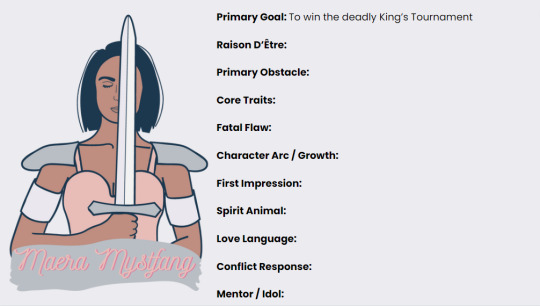
The story premise and primary goal of the protagonist are almost always interconnected. In this case, the story premise is a tournament to the death - and the character's main goal is to win that tournament, obviously.
But where there's room for some originality is in the raison d'être. This loosely translates to "reason for being" or "purpose". It's the why of it.
For example: what motivated this character to risk their life by entering such a tournament in the first place?
It is sometimes helpful to look at similar stories when thinking about this category. Not so you can copy their protagonist's motivations - but so you can do something different.
The whole selfless-self-sacrifice thing, for example - that's done. At least in relation to this particular sub-genre. We can do better for our hypothetical Maera Mystfang character.
Actually, let's really turn the trope on its head and make her raison d'être incredibly self-centred.

Already, this is character is shaping up to be something a little bit different within the niche of tournaments to the death. Which goes to show how putting a little bit of thought can go a long way, even with something as simple as identifying your character's initial purpose.
Primary Obstacle
Every protagonist needs a goal - and every goal needs an obstacle. This is what gives the story some tension and keeps readers turning the page.
An obvious choice of obstacle for this hypothetical character, since we're dealing with a fantasy romance, would be that Maera starts to develop feelings for one of her fellow competitors.
This concept has definitely been done, but that's okay. Not every section of this list has to break the mould. Tropes exist for a reason and it is totally okay to lean into them sometimes.
However, just for funsies, I'm going to try and put a slightly different spin on this one too.

Instead of the obvious "I love one of the people I'm meant to kill", let's make Maera's (previously dormant) conscience be the problem. Her reasons for entering the tournament may have been self-motivated, but as she gets to know her fellow competitors - admires some of them, even - she starts to second guess those reasons.
Core Traits
A lot of character templates will divide personality traits into positives and negatives - but I don't think this is particularly helpful. It is far too one dimensional - not to mention unrealistic. The key components of someone's personality aren't usually so black and white.
In fact, most core traits are both good and bad at the same time - it just depends on the context.
Instead of being wholly positive or negative, try to think of three core character traits that can serve as two sides of the same coin, with both positive and negative implications to each.

For Maera, I've given her these core traits:
Self-reliant;
Rebellious; and
Good-humoured.
Her self-reliance means that she is incredibly capable - but it's also the cause of her selfishness. She's always had to look after herself, so she expects others to do the same.
Her rebellious attitude means she isn't willing to accept the status quo. But at times she is also a rebel without a cause, causing trouble just for the fun of it.
Her good sense of humour means she is fun to be around, but she also tends to not take things as seriously as she should.
Thinking of core traits in this multi-faceted way not only adds realistic complexity, but it also sets you up well for showcasing character development and growth throughout the story.
Fatal Flaw & Character Arc / Growth
You've probably read negative reviews that throw around terms like "Mary Sue" or "Gary Stu". People tend to be over-zealous with these terms, especially for Mary Sue, but the gist of it is that the character in question is "too perfect".
They're the chosen one, they're good at everything, all the boys like them, etc.
Some characters can get away with this just fine. Look at Aragorn. He's the ultimate Gary Stu but I still swoon every time he opens those damn doors. You know the scene I'm talking about.
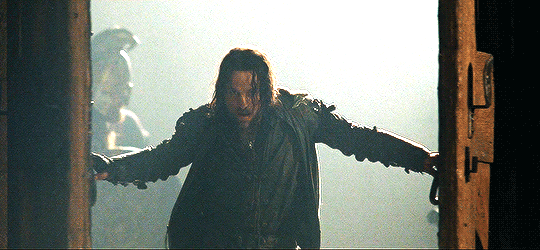
Ooft.
But for the most part, you want to incorporate a fatal flaw into your protagonists - because this is what gives them room to grow.
And, no. "I was born to be King but I don't wanna" does not count as a fatal flaw.
Instead, think bigger. Think worse. Think about where your character starts versus where you want them to end up. Think about how you want the events of the narrative to change their world view - or even their initial goal.

For Maera, her fatal flaw is pretty obvious, given her initial motivations for entering the tournament. Similarly, her growth/arc is linked to her primary obstacle, which is developing a conscious.
Her journey throughout this hypothetical story might be learning to appreciate how her past shaped her, while also acknowledging that there are things she can do to ensure others don't have to go through what she did. By being shown acts of kindness, she learns to appreciate their value.
First Impression
Now that we've covered all the "big picture" stuff, let's get into some of the smaller details that give your character some texture.
The first impression category is a hypothetical exercise where you image how your character might appear to a room full of strangers. In dual, multi, or omniscient POVs, you might even get the opportunity to include this impression somewhere in the story.
But even for first-person narratives, it is still worth thinking about, because it will help to inform how other characters interact and respond to your protagonist (at least at first).

For Maera, I've written this first impression as: a fun person to have a few drinks with - so long as you keep a close eye on your wallet.
From this description, we can guess that Maera probably likes to have a good time, but also comes across as untrustworthy. Whether that impression is deserved or not is up to you, as the author, to decide.
There's also a lot of deeper directions you can take this first impression category, too. Like if most people react to Maera this way, but one particular character doesn't, then your readers are going to sit up and pay extra attention during that interaction. Especially when that person reacting atypically is the future love interest.
Spirit Animal
Ah, this one is a fun one!
I always encourage my authors to assign a "spirit animal" to their characters - especially when they're doing multi-POV.
There are two main reasons for this:
It will allow you to assign some very distinct adjectives and verbs with that particular character; and
It is an opportunity to flesh out some additional character traits beyond the core traits.
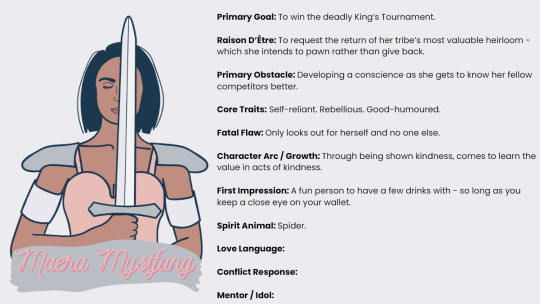
For Maera, I've chosen "spider" because she is solitary by nature, opportunistic, and patient.
But, more than that, I also like the idea of Maera being the kind of person who knows how to watch and wait. While her first impression might be "here for the good times", her joking façade is actually a mask she wears while carefully observing others.
For example:
Her words were laced with venom.
She crawled her way across the rooftop.
At some point, weaving lies had become more of a past time that a necessity.
Her thoughts were a tangled mess.
She didn't bother to conceal her predatory gaze.
Inch by cautious inch, she crept forward.
Her sanity was already hanging by a thread.
If there was one thing she knew how to do, it was spin a good story - truth be damned.
I've never outright compared Maera to a spider in these examples, nor have I made it blatantly obvious that that's what I'm doing. But by peppering these kinds or words throughout the story, I'll be able to subtly create a very distinct kind of impression for her character.
For comparison's sake, let's assign "cat" to the love interest. Examples of possible words to consider in this instance might be:
He clawed his way through the bushes.
"What are you doing?" he hissed.
The comment had some bite to it, that was for sure.
He slunk away into the darkness.
His still, unwavering focus was unnerving.
He prowled towards her.
In a few quick, agile steps, he'd made it across the parapet.
He yawned and stretched out beside her.
Of course, not every single word you use in association with a character needs to be related to their spirit animal. But keeping a certain type of animal in mind - and finding opportunities to throw in some subtle messaging through language choice - can be beneficial on so many levels.
It helps to distinguish your characters from one another through the kind of language you use to describe them - but it's also just really, really fun way to add some bonus texture to your characters. Giving your readers some little easter eggs like this is never a bad thing.
Love Language
If you're unfamiliar with the concept of the five basic love languages, then here's a quick visual overview:
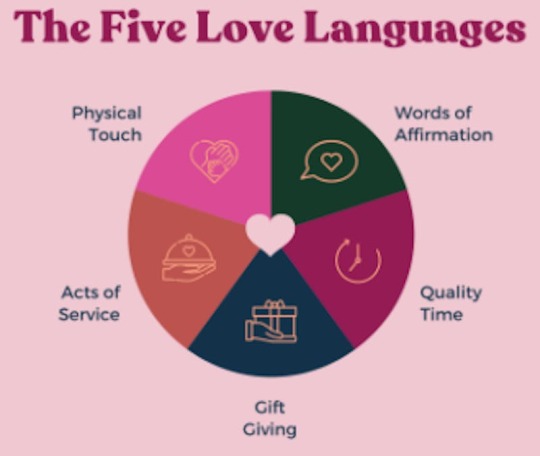
Love languages aren't a consideration that's specific to romance. They're important for friendships and familial relationships too.
Because thinking about what your protagonist values most in love is going to tell you a lot about who they are. Especially when you take the question deeper and think about why this is something they value.

For Maera, I've chosen "Acts of Service" because this ties in quite well to her character arc.
In terms of Maera's why, I could easily go with "because this was how she was shown love as a child" - and this is a good enough option most of the time. However, since her love language is very much tied into growing out of her fatal flaw, then I actually want to do the opposite.
Maera winds up valuing acts of service because this is something she craved - and wasn't given - as a child. She had to do things the hard way instead. Hence why she ends up appreciating the kindness of others so much. Such generosity is new to her - and precious.
Conflict Response
This is potentially one of the most overlooked character components. Conflict and tension is central to story telling, yet there is so little attention given to creating authentic, original responses to conflict.
The way I see it, there are three main considerations in regards to conflict response:
How your character reacts in the moment;
The unhealthy methods they use to deal with the aftermath; and
The healthy methods they use (or discover) to self-sooth.
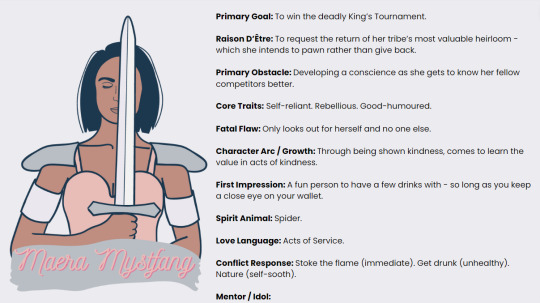
When faced with conflict, Maera's immediate reaction is to antagonise. She doesn't like to back down and enjoys creating trouble.
However, in the aftermath, the conflict affects her more than she lets on. She stews on it - and her solution to that is to get drunk until she can forget about it completely.
But even though she sometimes forgets it, Maera has a more healthy coping mechanism at her disposal. When she is surrounded by nature - in the forest, by the sea, whatever - it calms her.
In addition to identifying your protagonist's various responses to conflict, it is also helpful to think about why. Again, this is a great opportunity to insert something unique into their character backstory.
With Maera, for example, let's think about why she finds nature so soothing. Perhaps, amidst a very bleak childhood, one of her fondest memories is of picking grapes in a vineyard.
Perhaps the elderly woman who owned the vineyard was very rude and abrupt - but also quite kind to Maera in her own way. Maybe she would sometimes stitch up Maera's clothes or feed Maera a hearty, meaty dinner - even though she didn't have to.
If you're struggling to think of a real, tangible, unique memory such as this - then it's always helpful to go back to the old classic of write what you know. Think of a real life moment or memory - something that's stuck with you, no matter how simple - then adapt it to your character.
To create this vineyard example, I simply drew on my experience of picking strawberries with my Nonna after school.
Mentor / Idol
I could write an entire thesis on mentors. Or, more specifically, the "death of the mentor" trope - both in its literal and metaphorical interpretations.
But, for the sake of brevity, let's save that sh*t for another time and focus on what's important for a basic (yet complex) character template. And that is:
The Formative Mentor (past); and
Transformative Mentor (present).
The formative mentor (or idol) is someone who influenced your character prior to the events of the novel. Sometimes they're a character the reader will meet, or other times, they're long gone before the novel even begins.
The transformative mentor is a much looser term. It doesn't necessarily have to be a traditional mentor character, but rather it is a character who heavily influences or changes your protagonist throughout the events of the novel.

For Maera, I want her earliest idol to be a random female sell-sword who she crossed paths with. Prior to meeting this sell-sword, Maera was living without hope for a future, surviving on scraps and petty crime.
But after seeing an independent and moderately wealthy sell-sword in her local tavern, Maera got a glimpse into the kind of life that might be possible if she learned to fight. With the right kind of skills, she might be able to earn some decent money for a change - and travel the world.
This is an example of how "mentors" don't always have to be a wise wizard who oversees your protagonist's training and education. Young minds are impressionable - and even distant figures can have a lasting impact.
Just look at all the women who cite Legally Blonde as the reason why they were drawn to law. Elle Woods wasn't even real - but for plenty of young girls, she made an impact.
Similarly, your protagonist's "present" mentor or idol doesn't necessarily have to be a wise wizard either. It can simply be someone who motivates them to change their world view or strive to be better.
In romance, it is more than acceptable to have the present mentor coincide with the love interest - especially in standalone enemies-to-lovers. I know this seems counter-intuitive, since the word "mentor" implies a power imbalance, but it makes more sense if you readjust your definition of mentor to be "inspires change".
However, for Maera, I kind of like the idea of pairing her up with a love interest who shares some of her flaws. I vibe with the idea of making him a bit self-interested too, although for different reasons.
So in her example, I've listed the present mentor as a selfless secondary character. The way I would envision this going is Maera and the love interest team up early on - but somewhere along the way a secondary character saves them both. They're both heavily influenced by this character before this character sacrifices themselves. The aftermath of this incident rattles both Maera and her love interest, and serves as the spark for growth.

I hope you found this template - and very long explanation - useful!
#writing tips#character tips#book blog#writing#creative writing#character concept#originalcharacter#writeblr#writers on tumblr#writerscommunity#writer community#writer problems#writer things#original character#fantasy character#romance writing#writing advice#writer tips#writer tools#the smut analyst#raison d'etre#character traits#character tropes
164 notes
·
View notes
Text
New acquisitions. Time to get serious… a little bit. And mean.

Carla Hoch - Fight Write: How to write believable fight scenes
Michael J. Carlson - Hurting Your Characters: A writer’s guide to describing injuries and pain from the character’s point of view
Samantha Keel (@bysamanthakeel) - Ten B.S. Medical Tropes that Need to Die Today… and What to Do Instead: A scriptmedic guide
Sorry, Tyler…
Sorry not sorry, Xavier…
PS: Digging for references on Tumblr for Carla Hoch and Michael J. Carlson. As soon as I find one, I'll update the post.
13 notes
·
View notes
Note
could you share some tips on how you got into writing and anything you can share with us on how you got this big 👑
hi there 🫶🏻
this big? 🥹 I'm literally going to cry.
so I really got into writing when I was watching ,,Once upon a Time'' back then and I guess I got the idea from being unhappy with the plot and how the show ended
but on a more serious note, I discovered that fanfiction was a thing and then it kinda became my hobby. I write fanfiction because it gives me comfort hence why some of my topics are regarding mental health or just fluffy fics that are supposed to make the reader feel good.
the only real advice I can give is: write, write, write away. If you have a show, movie or a fandom that you are really passionate about then give it a go. In terms of the actual process of writing this is what I usually do/used to do:
I research a LOT. If I write for a fandom or a character that I don't know well, I do a lot of reading and watching. I study what the character wears, how they speak, what their little characteristics are and I make up my own headcanons beyond the show/movie in my mind or write them down.
I'm honest here. Sometimes ideas will just pop into your mind, sometimes I drive somewhere, overhear a conversation or a big one: song lyrics. I hear something and I get a certain idea and then when I have the time, I sit down and try to write.
I find it really helpful to create sentence starters or just story beginners and so there are different ways. Starting with describing the weather, the atmosphere or what a character is doing at that moment. I'm happy to share my starters and prompts with anyone if you would like.
and again don't be afraid to look for inspiration. there are some great prompt blogs out there like my favourite one: @littlewhispersofsolitude who post amazing ideas and you don't have to completely take their ideas but you can always scroll through their blogs to get some inspiration.
and lastly it's all about just typing away what comes to your mind. Your beginner things will be awful, unless you are secretly very incredibly talented and should consider switching careers. My beginners stuff on wattpad is bad and I considered deleting it but then I remembered that it's a reminder for how much my writing has improved over the years.
If anyone on here needs some more advice, would like some prompts, sentence starters or inspiration I am always happy to share, whether that is for the Sarah Paulson fandom or any other fandom or genre.
I hope this helped a little 🫶🏻
#asks#blogging#Sarah paulson#fandom#writing#fanfiction#on writing#creative writing#writerscommunity#writing community#writing tools#writer things#writing advice#writer community#writing techniques#writing prompt#writing stuff#writing tips and tricks#writer tools#writers of tumblr#writer blog#writers block#writers on tumblr#writer stuff#author help#author advice
10 notes
·
View notes
Photo

Websites are still an important tool for authors. Here is how to create a perfect one
(via How to create a perfect author website (infographic))
22 notes
·
View notes
Note
I’m so sorry I know you’ve answered this before but I can’t find the ask, do you still use zenwriter? I have a vague memory of them using AI or something so I wanted to check before I start using them. I really dislike writing in google docs but I’m not sure what else to use
I actually have switched over to FocusWriter, which is an improvement over ZenWriter, in my opinion. I can manually save works this way. I truly do not believe FocusWriter uses AI of any kind. There’s not been an update to my knowledge within recent years, and there’s no built in add on that would necessitate the use of AI either. I’m almost certain ZenWriter is the same.
5 notes
·
View notes
Text
Plot Generator
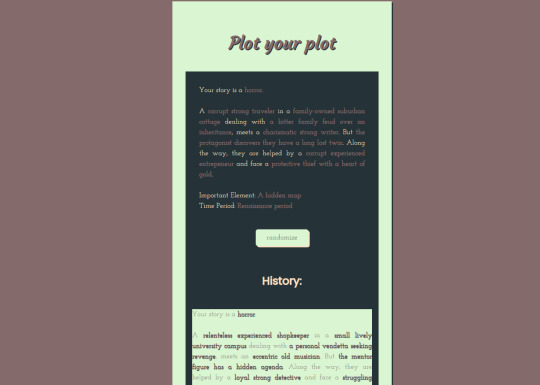
I created a plot generator thingy on Perchance!
Please let me know if you make something out of it ^^
6 notes
·
View notes
Text
Because I like writing and talking about writing, here's that sticky note story mapping thing again--progress has been made! Two stories--Sublimation and Rain's Redemption piece (proper title in progress).
Also, Duncan Idaho was incredibly helpful and only tried eating the sketchpad three times. You can see his little teeth marks at the bottom of the page with only one row of sticky notes and no color vomit.
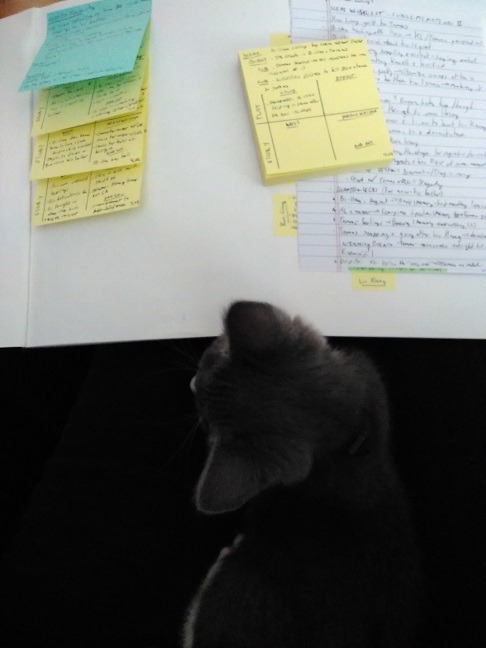


3 notes
·
View notes
Text
So, I have been knocking around the idea of possibly turning my prompt project into a bullet journal, as I've mentioned a couple times.
Here is a poll where I'm trying to narrow down or see what features I've come up with that writers may find useful and enjoy in a bullet journal.
Please either boost or vote (or both preferably) this so I can conduct further research and figure out what my next step will be once I have come up with my full list of prompts, which I am 60% of the way through writing. :D thank you, everyone!
#bullet journal#writers of tumblr#writer tools#writer bullet journal#bujo#writer bujo#mine#polls#tumblr polls
10 notes
·
View notes
Text

Comics can be an excellent source of inspiration for using onomatopoeia as punctuation in your storytelling.
These 15 examples show how sound can be used as a powerful symbol and carry meaning throughout your narrative.
The 15 Most Iconic Comic Book Sound Effects
Consider this effective example of author Gillian Flynn using onomatopoeia to bring to life a morning breakfast by building to the crescendo of a culinary orchestra in Gone Girl.
My morning breath warmed the pillow, and I changed the subject in my mind. Today was not a day for second-guessing or regret, it was a day for doing. Downstairs, I could hear the return of a long-lost sound: Amy making breakfast. Banging wooden cupboards (rump-thump!), rattling containers of tin and glass (ding-ring!), shuffling and sorting a collection of metal pots and iron pans (ruzz-shuzz!). A culinary orchestra tuning up, clattering vigorously toward the finale.
Here are a few other links on using sound in your writing.
Crash, Bang! How to Use Onomatopoeia Effectively
8 Memorable Onomatopoeia Examples From Literature, Advertising and Comic Books
Wikipedia list of onomatopoeias
How To Describe Sounds In Your Writing
The Writing Craft: Literary Devices of Sound and Rhythm
5 notes
·
View notes
Text
Everything You Need To Know About Writing Gunshot Wounds
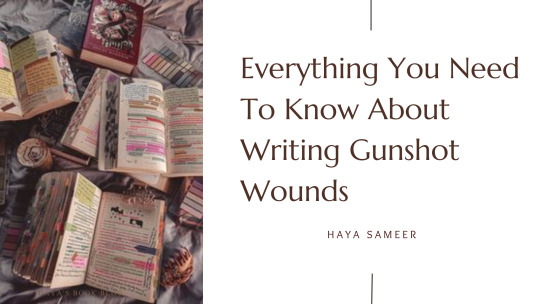
Welcome to the latest installment in my ongoing series on crafting realistic wounds in fiction! After covering stab wounds and burns, it's time to explore the next wound category frequently explored in fiction—gunshot wounds.
Gunshot wounds are a recurring motif in the realm of storytelling. They're something you can easily come across in every genre, however, authors often poorly portray gunshot wounds due to lack of proper research. I understand finding the right resources to aid with your writing can be hard, so here's my comprehensive guide on how to write gunshot wounds.
How To Categorise Gunshot Wounds
There are certain factors you need to consider before writing a gunshot wound. These details are instrumental in crafting a vivid and plausible narrative while avoiding plot holes. The first and most important one is identifying the type of firearm used to inflict the wound.
Picking The Right Firearm
Selecting the appropriate firearm to inflict a gunshot wound is a pivotal decision. It's not just about choosing any gun; it's about picking the right one to align with your desired outcome and the narrative's overall impact. Here's a quick guide on how to pick the right firearm.
The Impact of Firearm Selection
The firearm you choose can significantly influence the severity and appearance of the gunshot wound. Whether your goal is a graphic, gory injury or a precise, long-range shot, the choice of firearm plays a crucial role. Here are some guns you to consider:
Handguns: These are versatile and commonly used in close-quarters combat. They can result in gruesome, close-contact wounds with a higher potential for damage due to their stopping power.
Shotguns: Shotguns disperse shot pellets upon firing, making them suitable for creating a broader pattern of injuries. If you aim to depict a devastating, close-range gunshot wound, shotguns can be a fitting choice.
Rifles: Rifles are known for their accuracy at longer distances. When you need a precise, long-range shot, rifles are the go-to option. They tend to produce a cleaner wound channel, especially when used for a targeted, well-planned injury.
Choosing the Right Firearm for Your Narrative
The type of firearm you select should align with your story's objectives. If you intend to evoke visceral, gory reactions, opt for handguns or shotguns used in close proximity. On the other hand, if precision and long-range engagement are key, rifles can achieve your desired outcome.
Keep in mind that firearm selection can affect the wound's damage, trajectory, and overall portrayal in your narrative.
Categorising The Wound
Once you've identified the type of firearm, you need to establish what type of wound your character will incur.
In order to bring your character's injuries to life, it's important to first identify what you're dealing with. You can do this by categorising the injury based on several factors. For gunshot wounds, this includes the type of firearm used, the bullet's trajectory, and the specific areas of the body affected.
You can categorise your character's gunshot would into seven main categories, here's a quick breakdown of what these categories look like and the level of severity associated with them:
Penetrating Gunshot Wounds: These wounds occur when a bullet enters the body but doesn't exit. The bullet remains inside the body, causing damage along its path.
Perforating Gunshot Wounds: In this case, the bullet enters the body and exits on the opposite side. This type of wound can have a different set of implications due to the bullet's trajectory.
Ricochet Gunshot Wounds: Ricochet wounds happen when the bullet bounces off a surface before hitting the character. The nature of the surface can influence the severity of the wound.
Through-and-Through Gunshot Wounds: As the name suggests, these wounds occur when the bullet enters one side of the body and exits through the other. The trajectory can greatly affect the injury's severity.
Close-Contact Gunshot Wounds: These wounds result from the firearm being fired at extremely close range. The proximity of the gun to the body can lead to unique wound patterns and burn injuries.
Shotgun Wounds: Shotgun wounds differ from those caused by handguns or rifles. The shot pellets disperse upon firing, leading to a broader pattern of injury.
Long-Range Gunshot Wounds: When a character is shot from a considerable distance, the wound might appear different due to factors like bullet tumbling and loss of velocity.
The Anatomy of a Gunshot Wound
To create a vivid portrayal of a gunshot wound, writers need to grasp not only the external appearance but also the internal effects it has on the body. A well-executed description captures both the physical trauma and the emotional turmoil experienced by the character. Here are some symptoms you should take into consideration.
1. External Appearance and Bleeding:
Wound Size: The size of a gunshot wound can vary significantly based on the type of firearm and bullet used. Smaller calibers may leave entry and exit wounds that are relatively small, while larger bullets or high-velocity rounds can create much larger wounds. Be specific about the size, which can help readers visualize the injury.
Blood Loss: Gunshot wounds typically result in bleeding. The severity of bleeding depends on factors like the wound's location, the size of the blood vessels damaged, and the bullet's trajectory. Mention the amount of blood, but avoid excessive gore unless it serves a specific purpose in your narrative.
Coughing Up Blood: If the gunshot wound affects the chest or lung area, characters may cough up blood. This symptom often signifies a more critical injury and can add drama to your story.
2. Internal Damage and Symptoms:
Pain: Gunshot wounds are painful, and the character should express this pain through their actions, dialogue, and internal thoughts. Describe the sharp, burning, or throbbing sensations as they resonate through the character's body.
Shock: Depending on the severity of the wound, shock can set in. The character may appear pale, sweaty, and disoriented. This state of shock can impact their actions and decisions.
Loss of Function: A gunshot wound may impair the use of the injured body part. Describe any loss of function, such as the inability to move a limb or use it effectively.
Fainting: In extreme cases, characters may faint due to the pain, blood loss, or shock. Be sure to contextualize this within the narrative, as fainting can have significant consequences for the character.
By diving into the details of a gunshot wound's anatomy, you can craft a compelling and realistic portrayal that draws readers into the character's harrowing experience. I haven't exactly covered every symptom out there, but these are the major ones you should take into account when writing.
Medical Assessment and Treatment
Once you've established your gunshot wound, it's now time to focus on the aftermath. One of the main factors to consider is the medical process that follows. If your character is supposed to die from the gunshot then you could probably skip this section, but if they're alive here are things you need to consider.
1. Initial Assessment:
Scene Safety: In a real-life scenario, safety is paramount. First responders will ensure the scene is secure before approaching the injured person. Consider factors like the presence of firearms, potential threats, and the safety of medical personnel.
ABCs of Assessment: Medical professionals follow the ABCs—Airway, Breathing, and Circulation. Writers can reflect this in their storytelling by highlighting the character's ability to breathe, cough, or speak after being shot.
Vital Signs: Mentioning vital signs like heart rate, blood pressure, and oxygen saturation can help convey the character's condition and the urgency of their medical treatment.
2. Trauma Assessment:
Focused Assessment: Medical personnel perform a thorough examination to identify the gunshot wound's location, entry and exit points, and any associated injuries. This assessment informs their treatment plan.
Imaging: Depending on the complexity of the injury, X-rays or other imaging may be required to visualize the bullet's trajectory and any potential damage to internal organs or bones.
3. Treatment:
Bleeding Control: Stopping the bleeding is a top priority. This may involve applying pressure, packing the wound, or even tourniquet application in extreme cases.
Wound Care: Depending on the wound's severity, cleaning and suturing may be required. The character's response to this procedure can add an element of realism to your narrative.
Pain Management: Gunshot wounds are excruciatingly painful, and medical personnel will often administer pain relief or anesthesia during treatment.
Monitoring and Observation: Patients with gunshot wounds require careful observation and monitoring for signs of infection, complications, or changes in their condition.
By accurately portraying the medical assessment and treatment of gunshot wounds, you not only enhance the authenticity of your writing but also depict the physical and emotional toll such injuries can take on your characters. This attention to detail helps your readers connect more deeply with the story.
The Psychological Impact
Gunshot wounds don't just inflict physical harm; they also leave lasting emotional and psychological scars. It is important to note that the extent of the psychological impact on your characters will heavily rely on various factors.
For example, you need to consider whether or not this injury is something normal for them. Do they work as a spy, assassin, or other such roles that would mandate such dangerous injuries? You also need to consider who shot them. Does this wound come with emotional damage as well? Think of Aaron Warner’s reaction to Juliet shooting him.
If you’re sure your character will have some extent of a psychological impact, here are some factors you should consider.
1. Shock and Denial:
Immediate Response: Characters who have been shot may initially experience shock and denial. This can manifest as disbelief, emotional numbness, or a surreal sense of detachment from the situation.
Physical Symptoms: Shock can lead to physical symptoms like trembling, chills, or even fainting. Incorporating these details can make the character's reaction more genuine.
2. Fear and Anxiety:
Survivor's Guilt: Characters may grapple with survivor's guilt if they are the only ones to emerge unscathed in a violent encounter.
Anxiety: The threat of recurrence or the fear of returning to the location where the shooting occurred can trigger anxiety and panic attacks.
3. Post-Traumatic Stress Disorder (PTSD):
Flashbacks and Nightmares: Characters who have survived a gunshot wound may experience recurring flashbacks and nightmares, vividly reliving the traumatic event.
Hypervigilance: PTSD can lead to hypervigilance, where characters are constantly on edge, expecting danger at every turn.
4. Depression and Isolation:
Emotional Withdrawal: Characters may withdraw from social interactions, experiencing feelings of isolation and sadness.
Emotional Numbness: Some may describe feeling emotionally numb, unable to experience joy or pleasure.
5. Recovery and Resilience:
Therapeutic Support: In your storytelling, consider how characters seek therapy or counseling to cope with their emotional scars. Therapy can be a path toward recovery and resilience.
By addressing the psychological impact of gunshot wounds on your characters, you create more layered and relatable individuals within your narrative. This depth allows readers to connect with the characters on a profound emotional level.
I hope this blog on Everything You Need To Know About Writing Gunshot Wounds will help you in your writing journey. Be sure to comment any tips of your own to help your fellow authors prosper, and follow my blog for new blog updates every Monday and Thursday.
Looking For More Writing Tips And Tricks?
Are you an author looking for writing tips and tricks to better your manuscript? Or do you want to learn about how to get a literary agent, get published and properly market your book? Consider checking out the rest of Haya’s book blog where I post writing and publishing tips for authors every Monday and Thursday! And don’t forget to head over to my TikTok and Instagram profiles @hayatheauthor to learn more about my WIP and writing journey!
#hayatheauthor#haya's book blog#haya sameer#haya blogs#writers on tumblr#writer community#writer tools#writer blog#writer stuff#writer wednesday#writer tips#creative writing#writers of tumblr#writerscommunity#writeblr#writing community#writer spotlight#writer things#writing prompt#writing tools#writing stuff#writing#writing life#writing inspo#writing help#writing advice#writing inspiration#writing ideas#writing things#writing tip
2K notes
·
View notes
Note
Hi! It's the plotting anon/nonnie lol. I read your reply and thank you for that so much. I will consider what you said while trying to overcome my fear of actually writing. In the meanwhile, I'm asking this because I just got a concept idea for a likely dungeons and dragons campaign and/or a new wip, where do YOU choose to note down your ideas? Phone? Laptop? A notebook? Personally I like notebooks but something in me makes it harder to use notebooks because my brain says if I write down anything to a notebook about something specific, that entire notebook HAS TO BE about that thing. So it's really hard to have a notebook to just write down my ideas for me, my brain says "you wrote this idea now you DO SOMETHING ABOUT IT" so yeah, I just want a little perspective on how someone else does it <33
Take your time to answer this, no need to hurry
I hope you're having a lovely day.
Haha I have a few places I've taken notes. Mostly computer and notebooks.
I'm one of those "hoards notebooks" people, so I literally have entire notebooks dedicated to specific WIPs. I love having a whole space where I can write my notes for a WIP. And then I'll write the title of the WIP on the notebook so I can quickly find the one I'm looking for.
I also have this app called onenote. That is my favorite place I've taken notes. It's a Microsoft 365 program but it breaks things down. When I'm creating my casts or creatures for my WIPs, it's my favorite place to take notes about them because I can use separate tabs for each character/creature and have everything neat and orderly and easy to get to.
The other place I've taken notes down was google docs. I've taken notes on the notes app on my phone, but the second I discovered google docs has an app, it was game over for that app xD
So yeah, those are the 3 places I like to take notes. I prefer the first 2 if I have a choice but if I'm desperate to get notes down, I'll use google docs. Usually I prefer to use docs for actually writing the story.
Thanks for the question and I hope this helps! :D
Here is a screenshot of what onenote looks like to show you what I'm talking about:

The side where it says "Ezrah's love" on the right, those are also pages where you can make "tabs" or "pages" and then you can also tab them over like you're writing in a document. It's a pretty nifty program if you like to keep your notes organized.
🤍 H
15 notes
·
View notes
Text
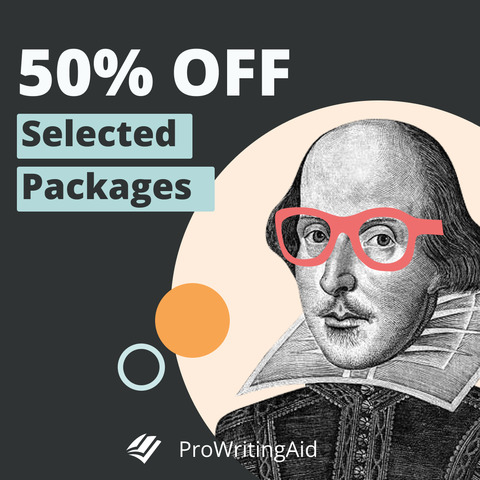
It's that time of year again, writeblr! ProWritingAid just kicked off their Black Friday sale and it's a goodie this time around, they've gone back to 50% off either the Lifetime or the Annual subs. (get the lifetime, it's worth it).
I have an affiliate link, so I'll get a little kickback if you'd like to use it, but you're under no obligation, of course!
https://prowritingaid.com?afid=5556
5 notes
·
View notes
Text

#writers#writers on tumblr#writing#writing prompt#writer#my writing#daily writing prompt#daily writing#writing tool#story#write it
48K notes
·
View notes
Link
You need this amazing free tool. I don’t know how I lived without it! No more wasting time calculating, the worksheet does it for you!
If Excel tells you it won’t open the worksheet in protected view, open Windows Explorer and right-click the file. Change the permissions to allow all users. Voila, the file is there for you to use again and again! Just remember to save it under a different name each time.
0 notes